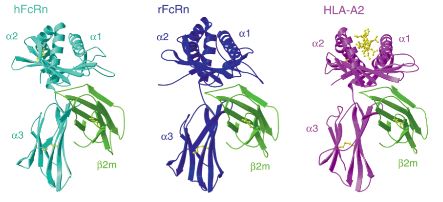FCGRT is encoded by the FCGRT gene which is located at 19q13.3. It belongs to the immunoglobulin superfamily which contains cell surface and soluble proteins participating in the recognition, binding, or adhesion processes of cells. FCGRT is a single-pass type I membrane protein, with its N-terminus on the extracellular side of the membrane and removal of its signal sequence. The molecular mass is about 39 KDa. FCGRT is like the MHC class I molecule in structure and related to beta-2-microglobulin.
| Basic Information of FCGRT | |
| Protein Name | IgG receptor FcRn large subunit p51 |
| Gene Name | FCGRT |
| Aliases | IgG Fc fragment receptor transporter alpha chain, Neonatal Fc receptor, FcRn |
| Organism | Homo sapiens (Human) |
| UniProt ID | P55899 |
| TransmFCGRTrane Times | Single-pass membrane |
| Length (aa) | 365 |
| Sequence | MGVPRPQPWALGLLLFLLPGSLGAESHLSLLYHLTAVSSPAPGTPAFWVSGWLGPQQYLSYNSLRGEAEPCGAWVWENQVSWYWEKETTDLRIKEKLFLEAFKALGGKGPYTLQGLLGCELGPDNTSVPTAKFALNGEEFMNFDLKQGTWGGDWPEALAISQRWQQQDKAANKELTFLLFSCPHRLREHLERGRGNLEWKEPPSMRLKARPSSPGFSVLTCSAFSFYPPELQLRFLRNGLAAGTGQGDFGPNSDGSFHASSSLTVKSGDEHHYCCIVQHAGLAQPLRVELESPAKSSVLVVGIVIGVLLLTAAAVGGALLWRRMRSGLPAPWISLRGDDTGVLLPTPGEAQDADLKDVNVIPATA |
FCGRT is a Fc receptor binding to the Fc region of monomeric immunoglobulins gamma. It is expressed in full-term placenta, heart, lung, liver, muscle, kidney, pancreas, and both fetal and adult small intestine. FCGRT is found in rodents for the first, it mediates the selective uptake and transport IgG, which bounds at the newborn rodent's apical surface of the intestinal epithelium, from milk. And the resultant FcRn-IgG complexes will release IgG into blood or tissue fluids. At the same time, it will help newborn animals to acquire passive immunity. Accordingly, FCGRT is possibly related to transfer of immunoglobulin G from mother to fetus. FCGRT also takes part in IgG immunoglobulin transcytosis in epithelial cells mediated by FcRn immunoglobulin receptor. Another important role of FCGRT is the protection of IgG from normal serum protein catabolism. Beyond that, FcRn can extend the half-life of IgG and serum albumin by reducing lysosomal degradation in endothelial cell.
 Fig.1 Structures of human FCGRT, rat FCGRT, and the class I MHC molecule HLA-A2 (West, 2000).
Fig.1 Structures of human FCGRT, rat FCGRT, and the class I MHC molecule HLA-A2 (West, 2000).
Authors in this article focus on genomic polymorphisms in rhesus macaque FCGRT. They test 75 animals and report the presence of a VNTR polymorphism in the promoter of FCGRT as well as a single nucleotide polymorphism in the signal peptide of β2-m.
This article reveals the relationship between breastfeeding and the onset of food allergies in offspring by instructing T reg formation via neonatal Fc receptor (FCGRT)-mediated transfer and uptake of allergen-containing IgG immune complexes (Ig-ICs) by gut dendritic cells (DCs).
Authors in this group focus on the FCGRRT-mediated recycling of albumin and the albumin fusion protein rIX-FP. The results reveal that FCGRT-mediated recycling via the albumin moiety is a mechanism for the half-life extension of rIX-FP observed in clinical studies.
This article suggests an FCGRT-dependent endosomal cellular-sorting pathway that plays a very important role in describing fundamental mechanisms of intracellular albumin recycling and the possibility to tune albumin-based therapeutic effects by FCGRT-binding affinity.
Authors in this article summarize some of the most novel results about FCGRT biology, immune as well as nonimmune, and provide some examples of FcRn-based therapies.
To obtain the soluble and functional target protein, the versatile Magic™ membrane protein production platform in Creative Biolabs enables many flexible options, from which you can always find a better match for your particular project. Aided by our versatile Magic™ anti-membrane protein antibody discovery platform, we also provide customized anti-FCGRT antibody development services.
As a forward-looking research institute as well as a leading custom service provider in the field of membrane protein, Creative Biolabs has won a good reputation among our worldwide customers for successfully accomplishing numerous challenging projects including generation of many functional membrane proteins. Please feel free to contact us for more information.
Reference
All listed services and products are For Research Use Only. Do Not use in any diagnostic or therapeutic applications.